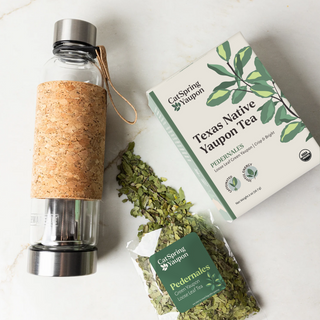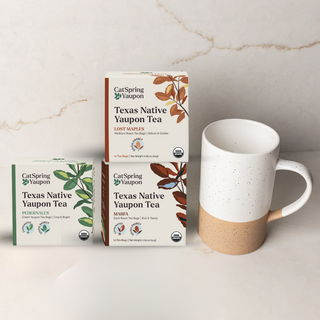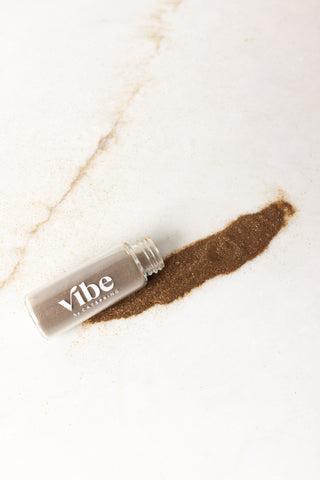Caffeine. It’s one of the most commonly used ingredients in the world. It’s been around for thousands of years. Many of us consume it multiple times daily.
But what is caffeine? How does it affect our bodies?
In this article, we’ll deep dive into what we know about caffeine and discuss some of the areas that we still have more to learn.
-
How did we find caffeine? A history of caffeine from its discovery over 4000 years ago to its predominance in our modern world.
-
Why do plants make caffeine? Uses plants have for caffeine that drive its natural production and creation, before we ever discovered it.
-
How do we absorb caffeine from our food? The processes that metabolize caffeine after we consume it.
-
How does caffeine affect our cells? The chemical and molecular interactions of caffeine and how these trigger cellular reactions.
-
How does caffeine affect our bodies? Results of studies that delve into how our bodies react to caffeine.
-
What is the difference between natural and synthetic caffeine? Maybe not as much of a difference as we may think.
-
How does caffeine from yaupon affect us? Find out more about sipping on your favorite cup of yaupon.
-
What about “Only natural source of caffeine native to North America”? Exploring this claim and common plants mistaken as caffeinated or as native to North America.

How did we find caffeine?
Early History
Caffeine is believed to have been discovered in about 2737 BC when the Chinese emperor Shen Nung noticed that some leaves fell into a pot of boiling water. The resulting brew was a delicious, aromatic beverage that we know today as tea (4). Caffeine is next heard of, in what may be an apocryphal account, in the 9th century in Ethiopia where a Sufi shepherd noticed that his goats got spurts of energy after eating berries off wild coffee plants. The shepherd made a brew from the berries and experienced similar energizing effects. 15th century records of African cultures using coffee as a stimulant are the next confirmed record of caffeine (28). From there, it spread to Egypt and North Africa. By the 16th century, coffee reached the Middle East, Persia, and Turkey where it then jumped the Mediterranean to Italy and mainland Europe. The Dutch then transported coffee to the East Indies and the Americas (6).

Photo Credit: Wikipedia
Caffeine in the Americas
The introduction of coffee by the Dutch isn’t the first time the Americas have encountered caffeine. Cocoa was domesticated in the Amazonian region over 5000 years ago and spread northward in the ensuing years (44). It was consumed in the Mayan empire as early as 600 BC. Cocoa beans were used as currency in some American cultures and chocolate was a luxury trade good.
Residue found in ancient pots record an ancient beverage created by the Mayan called xocoltatl. Xocoltatl is chocolate seasoned with vanilla, chile pepper, and achiote, creating a bitter and spicy drink believed to fight off fatigue. Xocoltatl was introduced to Europe via the Spanish and was a popular drink in the 1700s (6).
In South American countries such as Paraguay and Argentina, yerba mate was consumed by tribes, including the Guarani. The leaves were used in drink, as currency, and in trade amongst the tribes. It’s traditional preparation in a gourd or similar container has remained consistent for over five centuries (29).
Yaupon that flourished in southeast North America was used by Native American tribes to make the “black drink”. This beverage was consumed by warriors for purification and was a symbol of status in many tribes (6).
Caffeine Today
By the 1800s, caffeine in various forms was well known globally. It was then introduced in sodas such as Dr. Pepper, Coca-Cola, and Pepsi-Cola (6). From there, it has only grown in popularity. Today, 80% of adults globally consume caffeine daily. In the US, 90% of adults consume caffeine daily (1). Coffee and tea, some of the original sources of caffeine, remain the two most popular means of consuming it (4). Though caffeine has also been used in a multitude of products beyond beverages and chocolate. It is also used in skin and hair products, sauces, chewing gums, and medications (8).
Why do plants make caffeine?
Why did caffeine originate in plants in the first place? What is the natural function of caffeine?

For Protection
Caffeine is found naturally in over 60 plants. Some common sources of caffeine include the kola nut, the cacao bean, yerba mate, guarana berries, coffee beans, and tea leaves (4). In its host plants, caffeine is a natural pesticide that can paralyze or kill predatory insects feeding on the plant. It also offers young plants protection from competitors. Young coffee plants have elevated levels of caffeine as a chemical protection while they are still growing mechanical protection (6). Mechanical protection for plants include bark, waxy cuticle, spines, thorns, etc that provide physical protection for plants (30). The young coffee plants also leech caffeine into the soil where it inhibits the germination of nearby seeds, preventing them from sprouting. This preserves more local nutrients and resources for the young coffee plant, increasing the chances of survival (6).
For Pollination
However, caffeine can also help plants attract pollinators. Some plants, such as coffee, infuse caffeine into their nectar. When pollinators drink the caffeinated nectar, they get a slight buzz, enhancing their memory of the flower and increasing the chances they will return to pollinate again (31). The level of caffeine isn’t enough to be toxic, as it is when acting as a natural pesticide. Rather, this level is enough to affect the pollinator without killing them. As a study with honeybees showed, the low levels of caffeine in the nectar made the bee more likely to return to the flower and more likely to report it to the hive, resulting in even more bees pollinating the plant. Though the study found a catch. The bees would become almost addicted to the plant, returning even when it was no longer useful for food or pollination. Further studies into if this effect is seen in the wild are needed (45).

How do we absorb caffeine from our food?
From Our Food to Our Blood
How does caffeine get from our food and drink into our system? Caffeine rapidly absorbs from our digestive system into our blood stream. It takes about 50 to 175 minutes for caffeine to absorb from the stomach into the blood system. In the first 1 to 2 hours, 50% of the caffeine is out of our stomachs. By about 3.5 hours after consuming caffeine, 90% of it has transitioned to our blood stream. The peak plasma concentration is about 1 to 1.5 hours after consuming caffeine (4). Peak plasma concentration is one metric in ongoing studies on the effect of caffeine.
From Our Blood to Our Organs
Once caffeine is in the blood stream, it is transferred to the liver. 95% of caffeine’s primary metabolism occurs in the liver (25). There, it is metabolized into three primary metabolites—theobromine (3,7-dimethylxanthine), paraxanthine (1,7-dimethylxanthine), and theophylline (1,3-dimethylxanthine). Caffeine is also carried via the blood stream to the brain where it easily crosses the protective blood brain barrier (BBB) because it is water and lipid soluble (4). Once in the brain, it affects many of the changes we notice including increased wakefulness.
How does caffeine affect our cells?
Caffeine’s chemical name is 1,3,7-trimethylxanthine. This means that it is a xanthine base with three methyl groups attached around the molecule. It is a similar structure to adenosine, one of the 4 nucleotides that comprise DNA. Why does this matter? Because caffeine energizes us by blocking adenosine’s effects and increases activity of neurotransmitters such as dopamine and glutamate.
Adenosine is a neurotransmitter created cyclically by the brain. It builds up over the course of the day, increasing the feeling of tiredness and the desire to go to sleep (1). There are adenosine receptors throughout the brain, divided into four categories (6). For the purposes of this discussion, the A1 and A2A receptors are most significant. A1 receptors are found throughout the brain. But there are heavier concentrations in the hippocampus, cerebral, and cerebellar cortex, and certain thalamic nuclei. A2A receptors are located in dopamine rich areas of the brain (4).
Caffeine and Adenosine
Caffeine is an adenosine antagonist. Caffeine molecules are similar enough to adenosine molecules to bind to the same receptors and prevent adenosine from binding. Caffeine binds to all four varieties of adenosine receptors, but particularly effect the A1 and A2A receptors (6). In general, caffeine’s effects via the A1 receptors decrease neuronal firing and the release of neurotransmitters while via the A2A receptors it modifies dopamine neurotransmission (2).
The wakefulness effect of caffeine is from when it binds to the A2A receptors, particularly in the ventrolateral preoptic area (VLPO). When it binds here, it actually prevents a signal to stop. Arousal activates when histamine producing neurons (histaminergic neurons) release histamine. Arousal decreases when another molecule, called GABA, inhibits the production of histamine from the tuberomammillary nucleus. When caffeine binds to A2A, it reduces the production of GABA, allowing the tuberomammillary nucleus to continue releasing higher amounts of histamine, prolonging arousal (6).
Caffeine and Dopamine
Caffeine’s interaction with A1 and A2A also influence the behavior of dopamine. Dopamine is a neurotransmitter that contributes to our feelings of pleasure and satisfaction (27). There is evidence that A2Areceptors in certain areas of the brain, such as the striatum, can decrease the effect of dopamine (6). When adenosine binds to the A2A receptor, it seems to decrease the affinity of the dopamine receptor for dopamine, decreasing the amount of dopamine that binds to the cell. The cellular pathway activated by dopamine, leading eventually to our pleasure and satisfaction, isn’t triggered as much as usual because there is less dopamine binding to the cell.
There is also evidence for the A1 receptor decreasing inhibiting the intracellular pathways triggered by dopamine receptors. Thus, the A1 doesn’t affect the actual binding of dopamine to the cell in the same way as A2A. Rather, it affects dopamine’s effects once it binds to the receptor (26). However, as an adenosine antagonist, caffeine is able to alleviate these effects. By preventing adenosine from binding to its receptors, it allows dopamine to continue acting at higher levels and with greater efficiency in the brain, producing down the line increased feelings of pleasure and satisfaction.

How does caffeine affect our bodies?
Caffeine is the most used central nervous system stimulant in the world (3). Studies have looked at the extent of caffeine’s effects, its method of action within humans, the difference in effects on different people, and the variation between natural and synthetic caffeine (17, 20, 21). Below are a handful of the effects of caffeine shown in various studies.
Short Term Effects
Caffeine has shown positive effects on learning, memory, performance, and coordination. These are related to its ability to increase arousal and vigilance while decreasing fatigue. Though these effects are variable, they generally include improved reaction time, wakefulness, concentration, and motor coordination with peak performance of these effects at about 1 hour after consumption and they pass by about 3-4 hours after consumption. There is also evidence of improved physical endurance in aerobic and anaerobic exercise including sprint performance, cycling and running time performance, cycling power output, and delayed onset of muscle fatigue. Caffeine also appears to increase basal metabolic rate in adults (6).
Long Term Effects
Long term studies have found benefits of consistent, moderate caffeine consumption for preventing or mitigating risk for a number of diseases. Studies have shown that people who regularly drink coffee have a lower risk of developing Alzheimer’s disease over time (5). Additionally, it has been shown to increase weight loss and reduce overall risk for metabolic syndrome including diabetes type II and obesity (4). Some studies have even suggested caffeine has a protective role against skin-induced skin cancer from UV radiation-caused DNA damage (4). These long-term effects of caffeine may be supported by other compounds. For instance, coffee can deliver daily doses of compounds such as polyphenolics which have antioxidant properties, along with a dose of caffeine. The synergistic effect of these compounds and caffeine on our bodies, especially long term, is still under research.
Caffeine’s effects on the body are diverse and still under research. There is much we don’t know about the effects of caffeine on the body and over time. Research indicates that the normal amount consumed by adults (about 4 mg per kg of body weight per day) is well under the threshold for negative effects of caffeine. One study has indicated that an acute toxic amount of caffeine is about 10 g per day, which equals about 100 cups of coffee. Negative effects of caffeine consumption from dependence, overdose, or withdrawal include tachycardia (fast heart rate), anxiety, restlessness, and tremors (4).
What is the difference between natural and synthetic caffeine?
Making Synthetic Caffeine
Synthetic caffeine can be created in a lab often from theobromine (one of caffeine’s naturally occurring metabolites) or by using urea and another compound (such as chloroacetic acid, methyl chloride, or ethyl acetate) (8, 9, 11). Though some caffeine added to products is the caffeine that is extracted from decaffeinated caffeinated plants such as coffee (13, 15). This extracted caffeine powder is highly concentrated and can be lethal in a dose of just two teaspoons.
History of Synthetic Caffeine
Synthetic caffeine was pioneered by Emil Fischer in 1895 when he used uric acid to synthesize caffeine. But it wasn’t until the middle of the next century that large companies launched into commercially producing caffeine. In 1942, German company Boehringer Ingelheim built a synthetic caffeine plant. In 1945, Monsanto Chemical Co. in the US began developing the capabilities to mass produce caffeine in response to the growing caffeine shortage largely experienced by the soft drink industry. Leading brands like Coke, Pepsi, and Dr. Pepper were having to cut caffeine by almost 54% in the supply shortages caused by World War II. (47). Now, many methods are utilized to create caffeine for products from energy drinks and soft drinks to medications and health products.
To identify if the caffeine in your product is natural or synthetic, check the nutrition label. Naturally occurring caffeine is often listed as the plant form whereas if it just reads ‘caffeine’ that is likely synthetic caffeine (10).

Photo Credit: Morgan McCloy/NPR
Differences Between Synthetic and Natural Caffeine
There are many claims that natural caffeine is a better alternative than synthetic caffeine (10, 11, 12). While it appears that the caffeine molecules themselves are identical molecularly and in effect when they interact with receptors in the body, there is evidence that the other compounds consumed with naturally occurring caffeine affect its action in the body (9, 24). There is ongoing research into the effect of the moderation provided by the other compounds present with natural caffeine.
The common belief is that synthetic caffeine absorbs more rapidly into the body without these natural compounds. The hypothesis is that the natural compounds and metals present in natural caffeine sources bind to the caffeine and may alter the absorption rates. Synthetic caffeine’s faster absorption is supposed to result in a quicker spike of energy and faster crash later on. Additionally, by entering the body faster it may cause more side effects such as nervousness, difficulty sleeping, jitters, and a flushed face.
However, it is worth noting that many of these effects are still under investigation. There are studies that show little to no difference in the rate of absorption, the intensity or type of physiological effects, or the length of time for effects between natural and synthetic caffeine (18, 22, 23). Though one study has been able to differentiate between natural and synthetic caffeine via high-temperature reversed-phase liquid chromatography to isotope ratio mass spectrometry (HT-RPLC-IRMS) (16). More studies are needed to understand the differences between these two forms of caffeine along with the interaction of caffeine with other naturally occurring compounds.
How does caffeine from yaupon affect us?
There is about 30-40% less caffeine in yaupon than in coffee (42). Usually, yaupon has about 25 mg of caffeine. In yaupon, there are also numerous other natural compounds including theobromine, polyphenols, L-theanine, and chlorogenic acid (32, 40, 41). Studies have shown that each of these do influence caffeine’s effect in the body. Additional research is needed to understand the full extent of these influences, especially in human subjects, but we present here some current research that reflect these changes as seen in the review by Julie Schuster and Ellen S. Mitchell (19).

Theobromine and Caffeine
Theobromine is the ingredient in chocolate that boost your mood (an effect that may be boosted by the caffeine also found in chocolate) (14). Theobromine is also in yaupon. Though there is significantly more caffeine than theobromine in yaupon, with studies showing 5-10 times as much caffeine as theobromine (7, 46). It has less arousing ability than caffeine though it does somewhat decrease blood pressure and increase heart rate. In mice studies, over prolonged periods it improved motor learning in certain tasks. When caffeine is consumed with theobromine, studies have noted that blood pressure doesn’t rise as it does when caffeine is consumed alone, in part due to theobromine’s vasodilation effects. A slight selectively enhancing effect on caffeine’s increase in attention and decrease in reaction time was seen when combined with theobromine, further suggesting synergistic effects between the two compounds.
Polyphenols and Caffeine
Polyphenols, specifically flavonoids such as those found in yaupon, have an antioxidant capacity. Polyphenols can also be found in blueberries and help exert some of their antioxidant effects. Like theobromine, polyphenols can also cause vasodilation which may have cognitive effects by allowing increased cerebrovascular blood flow. Tea polyphenols, such as those found in green tea, have been associated with self-reported calmness and reduced stress. These calming effects have been seen in studies combining caffeine and polyphenol use, suggesting the tea polyphenols may reduce the negative effects on mood including the physiological reactions to anxiety.

L-Theanine and Caffeine
L-theanine has been shown to initiate the release of serotonin and dopamine in the brain, particularly in the hippocampus, hypothalamus, and the striatum. It also triggers the release of GABA which may contribute to its relaxing and anxiety-relieving effects. A 2014 study showed that caffeine and L-theanine have synergistic effects to further promote alertness, attention, and task-switching. Further studies have supported the beneficial effects of L-theanine in combination with caffeine. It’s calming effects aid in offsetting some of the negative side effects of caffeine such as jitteriness. It also appears to improve performance in attention-switching tasks, increased alertness, and improved recognition visual reaction time.
Chlorogenic Acid and Caffeine
Chlorogenic acid (CGA) has antioxidant and anti-inflammatory properties that may also have neuroprotective abilities. CGA, when isolated from caffeine, improved subjects’ moods and decreased anxiety. CGA with decaffeinated coffee also showed some improvement in working memory in healthy elderly subjects. Whether the anxiolytic abilities of CGA persist even when it is consumed with caffeine is still under research.
It is important that many of these results are still preliminary and in need of further research to confirm. Additionally, many of the studies have used rodent subjects and need to transition to human studies to confirm similar results. Future research into the specific effects of these compounds in conjunction with caffeine as found in yaupon is needed to know for sure how many of these translate over and to what degree.
What About “Only Natural Source of Caffeine Native to North America”?
It seems like a bold, broad claim for yaupon to be the only naturally occurring source of caffeine in North America. There are so many sources of caffeine today and many are sourced domestically from within North America. So why can we make this claim?
There are many plants that have natural caffeine that have been transplanted from other regions to North America. The size and range of North America is vast. This creates a diverse range of climates that allow for many imported plants to flourish even thousands of miles from their original home. Some plants are native to North America and may have compounds that are cousins of caffeine but are not caffeine itself. Because of these similarities, they may have effects that mimic caffeine or may be muted variations of the effects of caffeine.
Yaupon is the only plant that is native to the North American continent with caffeine.

Below are a few common sources of caffeine or caffeine-similar effects that are now found in North America.
Cassina (Dahoon Holly, Ilex cassine) is sometimes used also as a name for yaupon and has been considered as another candidate for the holly variety used in the Black Drink that traveled as far as Cahokia, though chemical analyses have largely indicated the holly used is yaupon (34). It’s often misattributed as having caffeine due to the fact that for some time yaupon was traded under the name “cassine”. Studies have yielded mixed results on the caffeination of cassina. Though it has shown up in very low levels in some studies (not enough to cause any effects), it has been absent in many other studies (33).
Cacao originated in South America, domesticated about 5,300 years ago, then gradually spreading to central America where it was domesticated in Mexico by the Olmecs about 1,500 years later (35). The Aztec and Mayan civilizations are amongst the most famous societies to enjoy and trade cacao, developing early versions of chocolate. In fact, the word “chocolate” originates from these early civilizations. It comes from the Nahuatl word “chocolatl” which means “hot water” (43). Cacao is caffeinated and is where we get chocolate.
Yerba Mate is also caffeinated and originated in South America around Paraguay and Argentina. The earliest records of its use by native populations are from the 15th century when Europeans came to the continent.
Cascara is a tea made from the husk of the coffee fruit which originated in Africa. It is the husk that is removed when harvesting coffee beans. It is caffeinated (although only about a quarter of the amount found in regular coffee) and has antioxidants.
Labrador Tea (Muskeg Tea) is found in the northern United States and in Canada. It has a compound, ledol, that can be restorative like caffeine though it doesn’t have caffeine (38).
Mormon Tea is part of the plant family, ephedra, that is found in Europe, central Asia, North America, and South America. Its name, Mormon Tea, came from a tradition of Mormons settling in Utah steeping the tea since it didn’t contain caffeine. Rather, it contains ephedrine and pseudo-ephedrine which are, like caffeine, central nervous system stimulants (39).
Dandelion Roots The roots of dandelions can be brewed into an herbal tea, though it doesn’t contain caffeine.

Photo Credit: Matt Stirn/BBC












